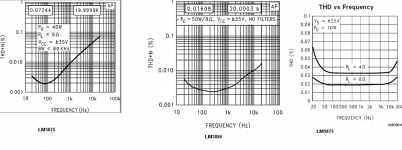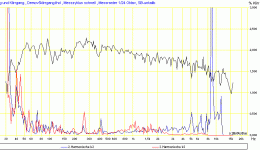Hi,
I need a chip with the lowest possible distortion and noise for an amplifier for measurements. I figured this would be the place to ask... Any suggestions?
It must be capable of delivering at least 10 watt into a load of 8 ohms.
The gain should be easily configured in the range from 20 to 30 dB.
Best regards
- Anders
I need a chip with the lowest possible distortion and noise for an amplifier for measurements. I figured this would be the place to ask... Any suggestions?
It must be capable of delivering at least 10 watt into a load of 8 ohms.
The gain should be easily configured in the range from 20 to 30 dB.
Best regards
- Anders
if you only need 10W the LM3886 is a very good choice in the inverting mode --- the LM4780 is a pair of LM3886 dies in one package and here's what it can do:
An externally hosted image should be here but it was not working when we last tested it.
Actually the 3875 has the lowest THD, noise and IMD among the entire range of National's chips (or is it the 1875?).
Also National specifies that inverting configuration may result in better THD+N.
However the input impedance drops in inverting mode so a preamp or buffer is needed, or a capable source.
Gain configuration is simple if the feedback loop consists of a fixed resistor + a variable resistor, with the variable providing a 10dB adjustment. Most of these chips should be able to handle this gain range just fine.
Or if you have a buffer you can set up the buffer for a 0-10dB gain and the chipamp for a fixed 20dB gain.
Also National specifies that inverting configuration may result in better THD+N.
However the input impedance drops in inverting mode so a preamp or buffer is needed, or a capable source.
Gain configuration is simple if the feedback loop consists of a fixed resistor + a variable resistor, with the variable providing a 10dB adjustment. Most of these chips should be able to handle this gain range just fine.
Or if you have a buffer you can set up the buffer for a 0-10dB gain and the chipamp for a fixed 20dB gain.
I think it is the 1875 that has the lowest figures, but it is a close contest from memory of looking at all the stats with the 2886 chip, I have a pair but I haven't done anything with them.
They will all produce 10 watts easily enough. Bridged chips and NAT Semi have a few including 3 channel versions (though they are not stellar performers) will give the lowest figures but they will not change crossover distortion fugures, but I guess for your implementation this is not an issue anyway.
They will all produce 10 watts easily enough. Bridged chips and NAT Semi have a few including 3 channel versions (though they are not stellar performers) will give the lowest figures but they will not change crossover distortion fugures, but I guess for your implementation this is not an issue anyway.
sangram said:Actually the 3875 has the lowest THD, noise and IMD among the entire range of National's chips (or is it the 1875?).
Here are some comparisons of THD+N from national's site. However , if you think about measuring loadspeaker's THD and other parameters , i don't think that amplifier will have much influence.While distortion of these amps is less than 0.1% , THD of loadspeakers may be a few percent.
Regards,
Lukas.
Attachments
Bazukaz said:While distortion of these amps is less than 0.1% , THD of loadspeakers may be a few percent.
I think that's a fairy tale... I did measurings with my speakers (not highend,but diy,visaton,2 x w170s8,1 x g20sc) see attachment.
The spikes are caused by room acoustics, blue is 2nd harmonic and red is 3rd harmonic. Crossover is at 2.5khz, the tweeter has <0.1% 3rd harmonic. Microphones are also distorting, so you see the product of soundcard/amplifier/speaker/microphone/soundcard.
Also, speakers are unlikely to create high order distortions if not defect.
The 3rd harmonics stop at 8khz in this measuring because of limited samplerate of soundcard.
I don't know where this myth originated that speakers have several % of thd...
Mike
Attachments
Thanks for the suggestions.
From looking at the figures achieved by jackinnj it looks as if the LM5780 is outperforming the other chips you suggest - that is the LM1875 and the LM3875.
In the 1875-datasheet it is said that:
"THD levels at 20 kHz with 10W output to an 8Ù load should be less than 0.05%, and less than 0.02% at 1 kHz."
Comparing with jackinnj curves at 1 kHz the THD+Noise for the finished amp is below 0.003%. Almost a factor 10 better. At 20 kHz the THD+Noise is below 0.02% - thats 2,5 times better for the LM4780.
Any comment on this? Can it be due to the inverting design?
From looking at the figures achieved by jackinnj it looks as if the LM5780 is outperforming the other chips you suggest - that is the LM1875 and the LM3875.
In the 1875-datasheet it is said that:
"THD levels at 20 kHz with 10W output to an 8Ù load should be less than 0.05%, and less than 0.02% at 1 kHz."
Comparing with jackinnj curves at 1 kHz the THD+Noise for the finished amp is below 0.003%. Almost a factor 10 better. At 20 kHz the THD+Noise is below 0.02% - thats 2,5 times better for the LM4780.
Any comment on this? Can it be due to the inverting design?
MikeB said:
I think that's a fairy tale... I did measurings with my speakers (not highend,but diy,visaton,2 x w170s8,1 x g20sc) see attachment.
The spikes are caused by room acoustics, blue is 2nd harmonic and red is 3rd harmonic. Crossover is at 2.5khz, the tweeter has <0.1% 3rd harmonic. Microphones are also distorting, so you see the product of soundcard/amplifier/speaker/microphone/soundcard.
Also, speakers are unlikely to create high order distortions if not defect.
The 3rd harmonics stop at 8khz in this measuring because of limited samplerate of soundcard.
I don't know where this myth originated that speakers have several % of thd...
Mike
Hi,
At what output power did you measure THD ? Did you measure IMD ?
Regards,
Lukas.
Anders_denmark said:Thanks for the suggestions.
From looking at the figures achieved by jackinnj it looks as if the LM5780 is outperforming the other chips you suggest - that is the LM1875 and the LM3875.
In the 1875-datasheet it is said that:
"THD levels at 20 kHz with 10W output to an 8Ù load should be less than 0.05%, and less than 0.02% at 1 kHz."
Comparing with jackinnj curves at 1 kHz the THD+Noise for the finished amp is below 0.003%. Almost a factor 10 better. At 20 kHz the THD+Noise is below 0.02% - thats 2,5 times better for the LM4780.
Any comment on this? Can it be due to the inverting design?
A well-implemented bridge amplifier should outperform a single-ended amplifier (gross generalisation) due to the harmonics being cancelled.
The National datasheet for the 4780 actually reflect quite accurately the results achieved by jackinnj in the bridge application. The numbers are almost identical, actually.
I feel better that I made the 4780 kits and not the 3875, but I always heard that the 3875 was better and the 1875 even better still...
sangram said:
A well-implemented bridge amplifier should outperform a single-ended amplifier (gross generalisation) due to the harmonics being cancelled.
The National datasheet for the 4780 actually reflect quite accurately the results achieved by jackinnj in the bridge application. The numbers are almost identical, actually.
I feel better that I made the 4780 kits and not the 3875, but I always heard that the 3875 was better and the 1875 even better still...
I have looked at the LM4780 datasheet and as you say it explain things. How about a bridged configuration using two 1875 - is that worth trying?
- Anders
Bazukaz said:Hi,
At what output power did you measure THD ? Did you measure IMD ?
Regards,
Lukas.
Hi, i can't tell exact numbers, but it was annoying loud. I guestimate >10watts.
I didn't measure IMD, my soundcard already had horribly high imd, and my new soundcard does not have mic-in and i am too lazy now to build mic-preamp.
I know that the IMD of the tweeter seems not audible, a signal 19+20khz didn't generate an audible 1khz.
Mike
jackinnj said:the bridged configuration also seems to cancel out the effects of power supply modulation --
fwiw, the first 250 boards are sold, maybe 10 or so left, so I ordered another 250 which should be here in a couple weeks.
Hi, maybe I'm blind, but what boards are these? A group buy? Where?
sangram said:
Hi, maybe I'm blind, but what boards are these? A group buy? Where?
I wrote an article on the amp -- you can get the Gerber files on the AudioXpress website free of charge as a zip file
http://www.audioxpress.com/magsdirx/ax/addenda/index.htm
-- figured that boards with a silk screen would be nicer so I had some made up and pushed them out the door on my website:
http://www.tech-diy.com/chipamps.htm
note -- the THD graph is a comparison of the prototype (home made boards) and the later ones -- the more you stew over a problem and figure which leads should be at right angles to each other the THD comes down quite a bit. in any case, careful dressing of the leads will yield a good performing amplifier, but careless dressing will cause a migraine headache.
- Status
- This old topic is closed. If you want to reopen this topic, contact a moderator using the "Report Post" button.
- Home
- Amplifiers
- Chip Amps
- Lowest noise and distortion Chip

